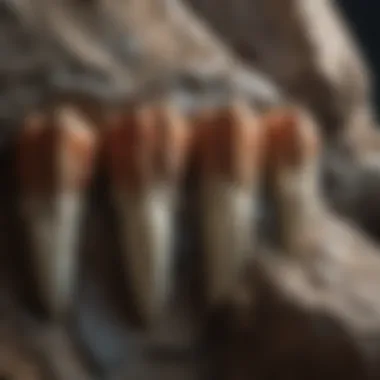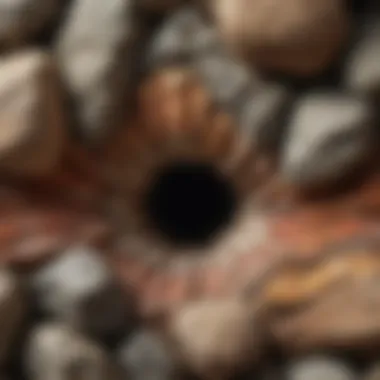Exploring Rocks with Teeth: An In-Depth Analysis


Intro
In the study of geology, rocks with teeth stand out as unique specimens. This category offers a lens into the rich tapestry of Earth's geological history. The significance of these formations extends beyond mere curiosity; they provide insights into ancient ecosystems and evolutionary processes. Understanding what constitutes rocks with teeth is essential for both amateur explorers and seasoned collectors. This article aims to demystify various aspects surrounding these intriguing specimens, guiding readers through identification, collection strategies, preservation techniques, and their geological implications.
Rock and Fossil Identification
When it comes to identifying rocks with teeth, one must first grasp the different types of rocks and fossils. Rocks with teeth often derive from sedimentary processes or represent unique fossilized remains. This section focuses on essential characteristics that help distinguish these formations.
Types of Rocks and Fossils
- Fossilized Teeth: Typically found in sedimentary environments, these can be remnants from various species, including prehistoric fish and reptiles.
- Toothed Rocks: Some rocks display natural formations resembling teeth, often due to erosion.
Characteristics to Look For
To identify rocks with teeth effectively, pay attention to the following traits:
- Texture: Look for a hard, sometimes shiny surface. Fossilized teeth have distinct patterns indicating their origin.
- Coloration: Varies based on mineral composition. Shades can range from dark to light, often revealing details about the rock’s formation process.
- Shape: Teeth shapes vary, often resembling conical or flat forms.
Tools for Identification
Utilizing specific tools can enhance the identification process:
- Hand Lens: A simple hand lens can magnify details like texture and patterns.
- Field Guidebooks: Resources such as Encyclopedia Britannica offer guidance on identifying various rocks and fossils.
Collecting Tips and Techniques
If you find interest in collecting rocks with teeth, knowing best practices is crucial. Here’s how to do it effectively and responsibly.
Best Practices for Collecting
- Respect Nature: Always follow local laws regarding collecting. Many sites have restrictions to preserve natural habitats.
- Document Your Finds: Keep a record of the location, date, and type of each specimen.
Locating Prime Collecting Sites
Some areas often yield richer finds:
- Riverbeds: Often expose sedimentary layers.
- Fault Lines: Can provide unique geological formations.
How to Safely Extract Specimens
To ensure you collect specimens without damaging them or their environment, carry the following tools:
- Digging Tools: Use small trowels or spoons for precise excavation.
- Containers: Bring sturdy containers to safely transport specimens.
Preservation and Display
Once specimens are collected, proper preservation and display techniques are paramount.
Techniques for Preserving Rocks and Fossils
To maintain their integrity:
- Clean Gently: Use soft brushes to remove dirt.
- Apply Consolidants: Consider using conservation-grade adhesives for fragile specimens.
Proper Storage Methods
- Acid-free Boxes: Store specimens in acid-free materials to prevent deterioration.
- Controlled Environment: Keep items away from excess moisture and direct sunlight.
Creative Display Ideas
To showcase your findings:
- Shadow Boxes: Create dynamic displays using shadow boxes.
- Glass Cases: Invest in glass display cases to protect your specimens while highlighting their features.
Geological Insights
Analyzing the geological context surrounding rocks with teeth enhances understanding of their significance.
Geological Formations and Processes
Rocks with teeth often originate from specific geological formations related to ancient riverbeds or ocean floors. Understanding these processes can reveal much about Earth's history.
Historical Significance of Rocks and Fossils
These specimens are crucial in piecing together evolutionary timelines and extinct ecosystems. They serve as physical evidence of ancient life forms, helping scientists and collectors alike understand past biodiversity.
Notable Discoveries in the Field
Several discoveries have reshaped our understanding of paleontology. For instance, the findings of shark teeth in sedimentary layers have provided insight into marine life millions of years ago. Such fossils are often invaluable in geological studies and enhance the value for collectors.


"Rocks with teeth capture a unique aspect of Earth’s history, showcasing both its biological and geological evolution."
Prelude to Rocks with Teeth
The concept of rocks with teeth is both intriguing and complex. These geological specimens possess unique characteristics that set them apart from ordinary rocks. Understanding this concept is essential for anyone interested in geology, paleontology, or rock collecting.
Rocks with teeth serve as a nexus between geological structures and biological processes. They highlight how natural formations are influenced by the presence of biological elements in the environment. This intersection provides key insights into Earth’s evolutionary history and the various processes at play in its formation. As collectors and enthusiasts delve deeper, they uncover valuable information about both the rocks and the conditions under which they were formed.
By examining the specific elements of these rocks, one can appreciate their uniqueness. This section will provide clarity on their definition, characteristics, and why the term "teeth" is applied to these formations. The exploration will allow collectors to engage with their specimens on a deeper level.
Definition and Characteristics
Rocks with teeth can be defined as geological specimens that exhibit features resembling dental structures. This term encapsulates a variety of formations that possess sharp, protruding textures reminiscent of teeth. The most notable trait of these rocks is their surface texture, which may be jagged or serrated, contributing to their distinctive appearance.
Characteristics of rocks with teeth include:
- Surface Texture: These rocks often have rough edges or shallow grooves that mimic incisor shapes.
- Composition: They can be composed of various minerals, including quartz, calcite, or even fossilized remains.
- Color Variability: The coloration can range from dull grays to vibrant hues, influenced by the mineral content and environmental conditions of formation.
Collectively, these traits contribute to the classification and identification of rocks with teeth. They offer vital clues to their geological history and environmental contexts.
Why 'Teeth' in Rocks?
The term "teeth" in rocks draws attention to both physical features and broader geological implications. The tooth-like structures reflect an evolutionary narrative, shedding light on life forms and environmental conditions of the past. Furthermore, the resemblance to teeth can also indicate the presence of specific biological activity during their formation.
In some instances, these formations arise from sedimentary processes where organic debris becomes compacted and mineralized. The sharp, tooth-like features may be a result of abrasion or weathering processes over time.
Understanding the significance of this terminology is crucial for collectors. It invites a deeper inquiry into the ecological and geological narratives that each specimen holds. This approach fosters a connection between the collector and their findings, elevating the practice of collecting beyond mere acquisition.
Formation Processes
Understanding the formation processes of rocks with teeth is essential for comprehending their unique characteristics and ecological significance. These processes provide insight into how these geological specimens have developed over time and the conditions that influence their formation. Recognizing these mechanisms allows collectors and enthusiasts to better appreciate and evaluate their finds in a geological context.
Natural Formation Mechanisms
Rocks with teeth often form through a variety of natural processes. The primary mechanism behind their formation relates to geological changes such as sedimentation, metamorphism, and volcanic activity. For instance, sedimentary rocks like limestone can capture bio-mineralized remains, leading to the appearance of tooth-like protrusions over millions of years. This sedimentation occurs when particles settle in water, compacting and cementing into solid rock.
Metamorphic processes also play a crucial role. In regions where heat and pressure are significant, existing rocks can transform into more complex forms. These conditions may create unique structures that mimic teeth, thus adding to their unusual morphology. Moreover, igneous rocks can exhibit peculiar features during their cooling phase, where certain minerals crystallize in ways that resemble dental structures.
Role of Biological Activity
Biological activity is another significant factor in the formation of rocks with teeth. Life on Earth interacts deeply with geological processes, and this influence often shapes rock formations. For example, marine organisms, such as certain types of coral and shellfish, can contribute to the development of rocks with toothed structures. Their skeletal remains may become part of the sedimentary rock, altering its composition and appearance over time.
Additionally, microorganisms are known to participate in the mineralization processes, facilitating the creation of calcified structures that imitate teeth. These biological influences underscore the interconnectedness of life and geology, illustrating how the presence of living organisms can impact rock formation.
"The intersection of biology and geology provides a unique perspective on how rocks can develop distinct features over time."
In summary, the role of biological activity in the formation of rocks with teeth highlights the significance of living agents in geology. As researchers explore these connections further, new insights will emerge, enriching our understanding of Earth's history.
Types of Rocks with Teeth
Understanding the types of rocks with teeth is crucial for rock and fossil collectors. Each type offers distinct characteristics, formation processes, and ecological implications. Knowing these differences not only enhances collecting experiences but also enriches one's appreciation for geological diversity. In this section, we will explore three primary categories: sedimentary rocks, igneous rocks, and metamorphic rocks.
Sedimentary Rocks
Sedimentary rocks represent one of the most common types of rocks that can feature what is colloquially referred to as "teeth." These rocks often form from the deposition of minerals and organic materials over time. Over long periods, these materials can compact and cement together, creating layers. This layering can sometimes result in the formation of sharp, tooth-like projections.
Key Features of Sedimentary Rocks with Teeth:
- Composition: Often composed of fragments from other rocks, minerals, and fossils.
- Formation Process: They form in places like rivers, lakes, and oceans.
- Examples: Fossilized shells or animal remains, like those found in limestone or sandstone, can appear as teeth.
Collectors should focus on identifying specific formations that hint at the presence of teeth. For instance, certain formations contain a wealth of fossils that, when weathered, expose pointed edges resembling teeth.
Igneous Rocks
Igneous rocks are formed through the cooling and solidification of magma or lava. While teeth-like formations are less common in this category, they can still occur. The cooling process can create sharp edges, often seen in volcanic rocks. The rapid cooling, especially on surfaces, might create unique textures with sharp protrusions.
Characteristics of Igneous Rocks with Teeth:
- Texture: Often fine-grained with difficulty in observing crystals, but may have areas with sharp edges.
- Formation Locations: Found primarily in volcanic regions or areas where ancient lava flows occurred.
- Examples: Basalt and obsidian can sometimes exhibit sharp features.
Collectors interested in these rocks should be attentive to their textures and surfaces. Observing the crystal structure could reveal tooth-like properties depending on the geographic location of the sample.
Metamorphic Rocks
Metamorphic rocks form from existing rocks that undergo physical or chemical changes due to heat and pressure. This category can yield fascinating specimens with teeth-like designs. The transformation process can lead to unique textures and shapes, which might resemble teeth.
Important Aspects of Metamorphic Rocks with Teeth:
- Formation Process: The intense conditions cause minerals to realign, forming new textures.
- Typical Locations: Frequently found in mountainous regions or areas affected by tectonic movements.
- Examples: Schist and gneiss might reveal layers and projections that imitate teeth.


Understanding how these rocks form enhances a collector's knowledge. Recognizing the relationship between pressure, heat, and the resultant features is valuable in identifying specimens that fit their criteria.
"Knowledge of different rock types enhances one’s collecting experience and appreciation for geology."
Ecological Implications
Understanding the ecological implications of rocks with teeth offers valuable insights into how these geological specimens fit into the broader context of the Earth's ecosystems. These rocks can play a critical role in habitats, influence environmental conditions, and provide clues about evolutionary processes. By examining the impact of these rocks within their ecosystems, collectors can appreciate their significance beyond aesthetic value.
Habitats and Ecosystems
Rocks with teeth often originate in specific environments that shape their formation and characteristics. From river beds to coastal regions, these rocks contribute to various habitats. For example, sedimentary rocks with unique tooth-like structures can serve as indicators of the conditions that existed when they formed.
In freshwater environments, the erosion of rocks can lead to the creation of tooth-like formations. These formations can impact water flow and provide microhabitats for diverse species. In marine settings, certain igneous rocks can influence coastal erosion patterns. They also serve as substrates for various forms of life, from coral to mollusks, contributing to the overall biodiversity.
Conversely, destabilizing environmental changes can impact these habitats. Understanding how rocks with teeth respond to such changes can offer crucial insights into ecosystem resilience. Collectors examining these rocks should note the surrounding environment, as it provides context for the rock's history and ecological interactions.
Fossil Record and Evolution
The fossil record is an invaluable repository of the Earth's history, and rocks with teeth often serve as platforms for the preservation of these fossils. Their specific formation processes can reveal evolutionary trends over millions of years. For example, sedimentary rocks in regions rich with fossils can demonstrate transitional forms of life, showing how species have adapted to changing conditions.
Recent studies indicate that variations in rock formation can provide information about past biodiversity hotspots. Fossils found within these rocks can shed light on evolutionary pathways and extinction events. The study of these fossilized remains helps scientists and collectors alike to reconstruct ancient ecosystems and comprehend the adaptive strategies of different species.
A careful examination of rocks containing fossil remains allows researchers to identify environmental pressures that may have influenced the evolution of various life forms. Therefore, each rock tells a story about the past, bridging our understanding of geology and biology.
"The study of rocks not only informs us about the Earth’s physical history but also offers a glimpse into the life forms that once occupied the planet."
By recognizing the ecological implications of rocks with teeth, collectors can cultivate a deeper appreciation of their specimens. This knowledge enhances the value of their collections and underscores the importance of preserving these geological treasures.
Significance in Geological Studies
The realm of geology encompasses a wide range of phenomena. Among them, rocks with teeth stand out due to their unique structural features and indicators of geological processes. Understanding these rocks contributes significantly to geological studies for several reasons.
Indicators of Environmental Change
Rocks with teeth often serve as indicators of past environmental conditions. Their formation can be closely linked to specific geological events such as volcanic eruptions, sedimentation rates, or tectonic shifts. By analyzing these rocks, geologists can deduce changes in the Earth's atmosphere, ocean circulation, and climate over various periods. This is vital for comprehending how the Earth has evolved over millions of years.
Research involving rocks with teeth can reveal:
- Shifts in sedimentary environments that highlight the changes in sea level.
- Evidence of biological activity during specific geological periods, which provides insight into ancient ecosystems.
- Key markers in stratigraphy that indicate the timing of significant climate events.
The implications of these indicators extend beyond geology. They inform fields like paleoclimatology and environmental science, allowing scientists to create better models predicting future climatic conditions.
Insights into Past Life
Another essential aspect of rocks with teeth is their role in providing insights into ancient life forms. Many of these rocks contain fossils or biological remnants that showcase the diversity of life and ecological dynamics of previous epochs. The teeth-like structures may preserve patterns of predation or competition among ancient species. By studying these formations, researchers can reconstruct ancient food webs and understand evolutionary processes.
Key points about fossils in rocks with teeth include:
- Fossil Orientation: The placement and orientation of teeth structures can indicate how organisms interacted with one another.
- Biodiversity Records: Rocks with teeth can act as a record of biodiversity during a particular geological era, highlighting mass extinction events or diversifications.
- Evolutionary Markers: These rocks may provide clues regarding the evolutionary timeline of certain species, helping scientists trace lineage and speciation events.
In summary, the significance of rocks with teeth in geological studies is profound. They are not merely geological curiosities but vital resources for interpreting the Earth's history. Geologists and paleobiologists alike find value in these specimens as they illuminate the complex interplay between geological processes and biological evolution.
Identification Techniques
Understanding how to identify rocks with teeth is pivotal for anyone interested in geology or fossil collecting. Correct identification not only allows a collector to appreciate the unique features of their specimens but also enhances their overall knowledge of Earth's history. Through identification, one can grasp the context of the geological processes that formed these rocks, discerning their origins and potential significance in ecological systems. The value of knowledge in the identification processes brings benefits that extend beyond mere aesthetic appreciation.
Visual Characteristics
Visual characteristics offer the first impression when attempting to identify rocks with teeth. These rocks often have distinct features that might point to their specific types or classifications. For example, textural elements such as roughness, smoothness, and color variations often indicate a rock's formation history. The 'teeth' structures, which can appear as sharp edges or protruding shapes, are critical identifiers. They may vary in size and distribution, reflecting the conditions under which the rock was formed. Each type of rock possesses unique visual markers that one should actively learn to distinguish.
When assessing visual characteristics, a collector might consider the following aspects:
- Color: Various minerals impart different hues, which can aid in distinguishing between rock types.
- Form: The shape of the teeth can indicate the rock's environmental history.
- Texture: The feel of the rock often reveals information about its weathering processes.
- Stratification: Layers in sedimentary rocks can also indicate their formation environment.
Collecting a visual reference guide may help in the identification process. Photographs of known specimens alongside described characteristics can serve as useful tools in fieldwork or collection evaluations.
Laboratory Methods
Laboratory methods provide a more in-depth approach to rock identification. Through scientific analysis, collectors can reveal compositional details that are not immediately visible to the naked eye. Such methods enhance understanding and provide empirical support to visual observation. In this realm, several techniques stand out, each serving a unique purpose.
- Thin Section Analysis: This process involves slicing a rock into ultra-thin sections for microscopic examination. The texture and mineral composition can be studied in detail, yielding valuable insights into the rock's geological context.
- X-Ray Diffraction (XRD): XRD allows for the identification of mineralogical components present in a rock. Different minerals will produce distinct diffraction patterns, making this method useful for precise mineral identification.
- Scanning Electron Microscopy (SEM): SEM provides high-resolution images of rock surfaces. It’s particularly effective at revealing the surface texture and fine features of teeth structures that might be crucial for identification.
Utilizing these lab methods can be expensive and time-consuming, yet they offer unparalleled accuracy in the identification process. Collectors, especially those serious about their specimens, find that investing in such techniques can significantly enhance their collections' credibility and educational value.
"Accurate identification of rocks with teeth is not just about admiration; it builds a connection to our planet's past and the processes that shape it."
Collectively, both visual characteristics and laboratory methods empower collectors with the necessary tools to understand and appreciate their rocks with teeth thoroughly. Enthusiasts are encouraged to engage with both approaches to deepen their exploration of this unique geological category.
Preservation Methods


Preservation methods are critical for maintaining the integrity and beauty of rocks with teeth. As unique geological specimens, these rocks can provide insights into natural history, but they require appropriate care to ensure that they do not deteriorate over time. Proper preservation can prevent physical degradation, maintain aesthetic qualities, and thus prolong their life for both personal collection and scientific study.
Storage Solutions
When it comes to storing rocks with teeth, choosing the right environment is key. Proper storage can help avert damage from environmental factors like humidity, temperature fluctuations, and light exposure.
- Temperature Control: Keep rocks in a cool area. Extremes can cause fractures or other harm.
- Humidity Management: Aim for low humidity. High moisture content can lead to mold growth or chemical reactions in certain rock types.
- Light Protection: Direct sunlight can fade and alter the color of minerals over time. Store them in darkened cases or wrapped in acid-free cloths.
Also, consider using display cases made from glass or acrylic. These materials allow for visibility while offering protection from dust and physical contact. Avoid metal containers that can rust or corrode.
Cleaning Techniques
Cleaning rocks is crucial to showcase their features without stressing their structure. However, it requires careful consideration of the cleaning materials and methods.
- Dry Brushing: Use a soft-bristled brush to remove dust. This method is gentle and does not introduce moisture.
- Soaking: For stubborn dirt, soaking in distilled water can be effective. Avoid soap or detergents which can leave residues.
- Use of Tools: When using tools, opt for non-abrasive materials. A wooden or plastic spatula works well for gently scrapping away contaminants.
- Drying Completely: After cleaning, ensure rocks are completely dry before storage to prevent moisture-related issues.
In the context of preserving rocks with teeth, maintaining their condition is not only a matter of aesthetics but also contributes to conservation practices in geology.
"Proper handling and conservation of geological specimens are essential for appreciating the story they tell about Earth’s history."
By employing effective storage solutions and proper cleaning techniques, collectors can ensure that their rocks with teeth remain beautiful and informative pieces of natural history for many years ahead.
Cultural Perspectives
Understanding the cultural perspectives surrounding rocks with teeth is essential in appreciating their significance beyond strictly geological parameters. These rocks carry not only a scientific value but also a profound cultural resonance that reflects human interaction with the natural world. The significance of these specimens can vary across different cultures, showcasing unique value systems and traditions.
Several factors illustrate the importance of cultural perspectives in the context of rocks with teeth:
- Symbolism: In various societies, fossils or similar geological specimens are often seen as symbols of strength or resilience. Their unusual formations can inspire tales of survival against odds, resonating with human experience.
- Tradition and Ritual: Specific rocks may play a crucial role in traditional rituals or spiritual practices. Some cultures regard them as offerings, while others might use them in healing ceremonies, believing in their metaphysical properties.
- Art and Artifacts: The aesthetic value of rocks with teeth cannot be overlooked. Many cultures create art inspired by their shapes and forms. This artistic expression not only reinforces community identity but also reflects the deeper connections humans share with nature.
Incorporating cultural perspectives into the study of rocks with teeth helps foster a more holistic understanding of these geological specimens. It encourages collectors to engage thoughtfully with the items they uncover, acknowledging the stories embedded within them.
Rocks in Mythology and Folklore
Rocks with teeth often appear in various myths and folktales. These stories indicate how societies have historically interpreted the presence of strange or remarkable geological features. For example, numerous cultures attribute significant meanings to teeth-like formations in rocks, linking them to ancient giants or beings that once roamed the earth. These narratives not only stir curiosity but also serve to connect generations through shared folklore.
- Giant’s Tooth: In some folklore, enormous stone formations resembling teeth are viewed as the remnants of giants. Such stories promote an engagement with the natural landscape and inspire exploration.
- Cautionary Tales: Legends also exist that warn individuals against trespassing on sacred sites where these stones reside. They enhance local respect for nature’s oddities and preserve essential aspects of community traditions.
These tales enrich the experience of discovering rocks with teeth, turning simple geological exploration into a storytelling venture. They remind collectors that each specimen can serve as a bridge to past cultures and beliefs.
Modern Collecting Trends
In recent years, the trend of collecting rocks with teeth has gained popularity among enthusiasts. It signifies a growing fascination with unique natural formations and reflects broader movements in the realm of hobbies and interests.
Key aspects of modern collecting trends include:
- Increased Accessibility: With the rise of online communities on platforms such as Reddit and Facebook, collectors can now share finds, tips, and insights freely. This engagement fosters a collaborative environment where knowledge and stories are exchanged.
- Sustainability Concerns: Modern collectors are increasingly aware of the environmental impact of their activities. Many prioritize ethical collecting practices, sourcing rocks responsibly to minimize harm to local ecosystems.
- Educational Focus: There has been a notable shift toward educational aspects of collecting. Many collectors research the geology and history behind their specimens. This remarkable trend serves not only individual growth but also contributes to broader educational outreach.
In summary, understanding the cultural perspectives surrounding rocks with teeth allows collectors to appreciate their finds from multiple angles. Whether through mythology, folklore, or current trends, these specimens weave a rich tapestry that extends beyond mere geological interest.
Practical Steps for Collectors
The pursuit of rocks with teeth is a fascinating and rewarding endeavor amongst geology enthusiasts and collectors. Engaging in practical steps for collecting these geological gems enhances understanding, enjoyment, and appreciation of the specimens. This section focuses on key elements that guide collectors in their journey, providing both foundational knowledge and specific strategies to optimize collection success.
Where to Find Rocks with Teeth
Identifying potential locations for finding rocks with teeth is the first step for serious collectors. Natural formations often contain these unique specimens. Here are some suggestions for prospective sites:
- Riverbeds and Streambanks: Erosion reveals rocks and sediments, often resulting in tooth-like rocks being exposed.
- Cliffs and Quarries: Areas where rocks have been extracted can provide insights into geological layers. Fossils and other significant rocks might be tucked away.
- Coastal Areas: Shorelines can yield interesting finds, especially after storms when water washes up materials.
- Caves and Karst Landscapes: Speleothems and sediment in caves may include unusual rock formations.
Keep an eye on local geology. Regions that experienced significant geological events may yield greater diversity in specimens. Engage with local geological societies to learn about field trips or events focused on rock collecting.
Building a Collection
Forming a well-rounded collection requires careful consideration and strategy. Here are steps to build a valuable and informative collection:
- Research and Education: Understand various types of rocks with teeth. Familiarize yourself with the geological context, possibly by consulting resources like Britannica and Wikipedia for ideas.
- Cataloging: Keep organized records of each specimen’s location, characteristics, and any pertinent historical or geological information. This can be done via notebooks or digital tools.
- Ethical Collecting: Always respect local laws concerning rock collection. Collect responsibly and ensure that habitats are preserved for future generations. Engage with stones mindfully, understanding their ecological significance.
- Networking: Connect with other collectors and join forums such as Reddit or specialized clubs. Exchange knowledge and possibly specimens with peers.
- Enhancing Display: Once obtained, consider how to display the rocks. Proper showcasing enhances their visual appeal and encourages examination and appreciation.
"Collecting is not just about obtaining objects; it's about understanding the stories behind them, the journey through the natural world they represent."
In summary, practical steps for collectors provide essential guidance on where to find these fascinating rocks and how to build a thoughtful collection. This structured approach benefits both beginners and seasoned collectors, enabling deeper connections with the natural history encapsulated in rocks with teeth.
End
In summation, the exploration of rocks with teeth serves as a significant component within both geology and collecting communities. This particular category not only piques the interest of collectors but also provides valuable insights into Earth's history, evolution, and the ecological conditions that have shaped our planet. Such rocks, with their unique formations and characteristics, tell a story that spans millions of years.
Recap of Key Insights
Rocks with teeth demonstrate remarkable formations that illustrate various geological processes. From their natural formation mechanisms to the role of biological activity, these pieces carry history etched in their very structure. Key takeaways from this article include:
- Diverse Types: Understanding the differences among sedimentary, igneous, and metamorphic rocks with teeth widens the knowledge base for both amateur and advanced collectors.
- Ecological Importance: The ecological implications of these rocks help in deciphering historical habitat conditions and species adaptation over time.
- Identification Techniques: Visual characteristics and laboratory methods offer practical ways for collectors to discern and classify their finds effectively.
- Cultural Relevance: Cultural perspectives surrounding these rocks highlight their significance not only in scientific contexts but also in mythology and personal collections.
Future Directions in Research
Future research in this domain can take several promising directions. There remains untapped potential in utilizing advanced technology for studying rock formations. For instance, employing 3D imaging techniques or AI-driven analysis could enhance identification methods and preservation strategies. Moreover, the interaction between geological formations and climate change presents an area ripe for exploration. Understanding how these rocks respond to shifting environmental conditions could shed light on the broader impacts on ecosystems.







